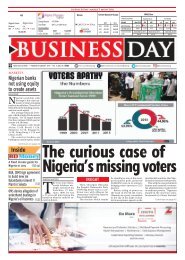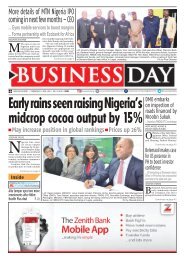BusinessDay 26 Feb 2018
Create successful ePaper yourself
Turn your PDF publications into a flip-book with our unique Google optimized e-Paper software.
40 BUSINESS DAY<br />
C002D5556 Monday <strong>26</strong> <strong>Feb</strong>ruary <strong>2018</strong><br />
MondayMorning<br />
In association with<br />
Harvard<br />
Business<br />
Review<br />
We need to approach artificial intelligence<br />
risks like we do natural disasters<br />
PRASHANTH GANGU<br />
The risks posed by<br />
intelligent devices<br />
will soon surpass<br />
the magnitude of risks<br />
associated with natural<br />
disasters. Tens of billions<br />
of connected sensors are<br />
being embedded in everything<br />
ranging from industrial<br />
robots and safety<br />
systems to self-driving<br />
cars and refrigerators.<br />
Our growing reliance on<br />
so many intelligent, connected<br />
devices is opening<br />
up the possibility of global-scale<br />
shutdowns.<br />
INTELLIGENT DEVICE<br />
RECOVERY PLANS:<br />
As with the risks associated<br />
with natural disasters,<br />
companies cannot completely<br />
protect against<br />
smart-device risks by buying<br />
insurance; they must<br />
have worst-case scenario<br />
recovery plans. Managers<br />
have to figure out their<br />
higher and lower risk intelligent<br />
device vulnerabilities,<br />
add in redundant<br />
systems and potentially<br />
set up the A.I. equivalent<br />
of tsunami early-warning<br />
systems. In addition, they<br />
need the ability to switch<br />
to manually controlled<br />
environments in case artificially<br />
intelligent systems<br />
have to be shut down,<br />
and to recall faulty smart<br />
products.<br />
INSURANCE PRODUCTS<br />
AND SERVICES:<br />
Insurers should quantify<br />
their exposure to a global<br />
intelligent device meltdown,<br />
offer new products<br />
and advise companies<br />
and governments.<br />
As they have for natural<br />
catastrophes, insurers<br />
can also encourage<br />
public sector safeguards.<br />
Since insurers cannot<br />
completely mitigate the<br />
outsized risks posed by<br />
extreme weather events,<br />
governments of many<br />
developed countries and<br />
international organizations<br />
provide natural ca-<br />
tastrophe relief through<br />
government agencies.<br />
Insurers need to help mo-<br />
bilize similar public sector<br />
resources to help the<br />
potential victims of an<br />
Are the most innovative companies just the ones with the most data?<br />
A.I.-enabled smart device<br />
disaster.<br />
INTERNATIONAL PRO-<br />
TOCOLS:<br />
Finally, policymakers<br />
should establish international<br />
trust and ethics<br />
guidelines to govern the<br />
development and implementation<br />
of ever more<br />
advanced A.I. products<br />
and systems. To reduce<br />
the future impact from<br />
natural disasters, governments<br />
and international<br />
organizations like the Red<br />
Cross and the World Bank<br />
collect and share data concerning<br />
the destructive<br />
ramifications and the support<br />
required to help victims.<br />
Similar intelligence<br />
will be critical to curb the<br />
impact of potential smart<br />
device shocks as artificial<br />
intelligence evolves.<br />
(Prashanth Gangu is a<br />
partner in the insurance<br />
and digital practices at<br />
Oliver Wyman.)<br />
VIKTOR MAYER-<br />
SCHÖNBERGER AND<br />
THOMAS RAMGE<br />
The cases of startups<br />
with superior ideas<br />
dethroning well-established<br />
incumbents are<br />
legion. For decades, “creative<br />
destruction” ensured<br />
competitive markets and a<br />
constant stream of new innovation.<br />
But what if that is<br />
no longer the case?<br />
The trouble is that the<br />
source of innovation is shifting<br />
from human ingenuity<br />
to data-driven machine<br />
learning. Of course, it takes<br />
plenty of talented, creative<br />
people to build these products.<br />
But their improvement<br />
is driven less by human “a<br />
ha” moments than by data,<br />
and improvements in how<br />
machines learn from it.<br />
Sometimes companies<br />
have to go out and collect a<br />
specific kind of data; think<br />
of Google’s cars roaming<br />
the streets of Silicon Valley.<br />
And sometimes companies<br />
pay for access to data so that<br />
their systems can learn. But<br />
more often than not the data<br />
that fuels innovation is being<br />
generated by users interacting<br />
with an existing digital<br />
service. When we accept Siri’s<br />
suggestion, it’s feedback<br />
to Siri that she got it right.<br />
If innovation is founded<br />
on data rather than human<br />
ideas, the firms that benefit<br />
are the ones that have access<br />
to the most data. Therefore,<br />
in many instances, innovation<br />
will no longer be a<br />
countervailing force to market<br />
concentration and scale.<br />
Instead, innovation will be a<br />
force that furthers them.<br />
The specter of companies<br />
with access to data becoming<br />
data-driven innovation<br />
leaders, leaving smaller<br />
competitors and startups<br />
behind in the dust, should<br />
concern policymakers intent<br />
on ensuring that markets<br />
stay dynamic and competitive.<br />
Their challenge is less to<br />
realize the problem than to<br />
devise a solution that keeps<br />
markets competitive without<br />
stifling data-driven innovation<br />
on the whole.<br />
For many innovative<br />
companies, the next few<br />
years will be a time of reck-<br />
oning: As the power of datadriven<br />
innovation increases,<br />
these more conventional innovators<br />
will have to find access<br />
to data to continue to innovate.<br />
That necessitates at<br />
least two huge adjustments.<br />
First, they need to reposition<br />
themselves in the data value<br />
chain to gain and secure data<br />
access. Second, as innovation<br />
moves from human insight<br />
to data-driven machine<br />
learning, firms need to reorganize<br />
their internal innovation<br />
culture, emphasizing<br />
machine learning opportunities<br />
and putting in place<br />
data exploitation processes.<br />
(Viktor Mayer-Schönberger<br />
is professor at Oxford.<br />
Thomas Ramge is technology<br />
correspondent for brand<br />
eins and also writes for the<br />
Economist.)<br />
(C) (2017) Harvard Business Review. Distributed by New York Times Syndicate


















